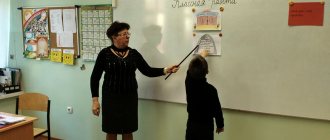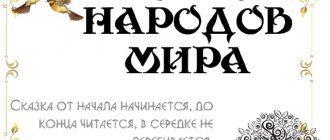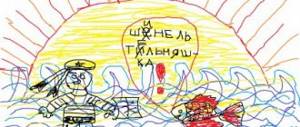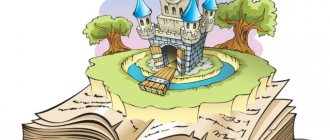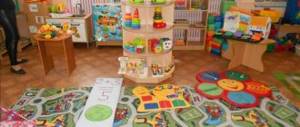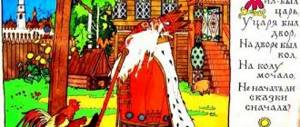What is a mathematical fairy tale
A mathematical fairy tale is a literary text based on the adventure genre. In the plot, the main characters are associated with certain mathematical concepts, which have an unusual, “live” appearance that attracts the attention of readers. Fictional characters perform logical operations during feats, and the child carries out the process in his head, which is the primary task of game learning. It is amazing that in fairy tales there is often no logic, but in mathematical fairy tales it imperceptibly settles in the memory of listeners with valuable knowledge.
In kindergarten, comprehension of mathematical fundamentals begins with the younger group. The teacher must prepare children for the gradual development of the initial laws of logic and other important learning processes. If we are talking about fairy tales, then in the younger group children should read them more often before quiet time, since at home most parents prefer TV and games on tablets and smartphones. This fact is confirmed by statistics compiled in Russia by Online Market Intelligence (OMI) in 2012.
The percentage of parents who are ready to pass on their gadgets to their children (indicating the child’s age). About 4,000 people took part in the survey. If parents are ready to work with their child on their own, books of fairy tales for little ones will come to their aid. For example, “The Adventures of Kubarik and Tomatik, or Fun Mathematics” by G.V. Sapgir and Yu.P. Lugovskoy. This book invites children to go on adventures with their friends - Tomatik and Kubarik - and find out what one, many, higher, lower, longer, shorter, etc. mean.
Mathematical tales
And Krug’s friend, on the contrary, was calm, serious and reasonable. He stood very firmly on his feet, was never in a hurry and, almost always, was bored and alone, because Krug was rushing somewhere on the right, then rolling down the mountain to the left and was never with him. And in the city of Geometric Figures his name was Square, and he was respected for his constancy and modesty.
When friends quarreled, Krug scolded Kvadrat for his slowness and clumsiness. Sometimes Kvadrat would get offended and mutter angrily: “It’s good for you, you’re round and smooth, you roll like a bun and never stop when you’re asked. You can only stop when they trip you up or you run out of strength.” But I only know how to roll from side to side. I have sharp corners, and I have four of them (demonstration and display). So they interfere with movement.”
When Krug realized that he had offended his friend, he began to calm him down. “Don’t be upset, my friend, the reason you are a square is because you have four beautiful right angles. And if it weren’t for them, you would be the same as me. And everyone should be themselves. I believe that the Square is much more useful for people than the Circle. Just imagine a car without wheels. This is a car in need of repair. Now imagine wheels without a car. Wheels are wheels. This is just a small part to make the car move.”
Kvadrat listened attentively to his friend and thought: “Thank you, Krug, for the consolation. You say everything correctly, but you just don’t know one thing - if it weren’t for circles and wheels, we would still be walking, waddling from side to side, at a snail’s pace, and we would never did not reach the city of Geometric Figures. »
Fairy tale: Visiting the Queen of Mathematics.
This story happened in one city. With a very ordinary boy, whose name was Seryozha. Like all boys who turned 6 years old, Seryozha loved to play with toy cars more than anything in the world. In the summer the boy played football with friends, and in the winter he played hockey. Serezha’s parents often said that he would soon go to school in the 1st grade. But the boy did not want to go to school. He enjoyed going to kindergarten. One day on a day off, his younger sister Ira came up to Seryozha and handed him a box of sweets. “Seryozha, help me, I can divide the candy equally,” the girl asked. Ira was 2 years younger than her brother and did not yet know how to count. Seryozha, narrowing his eye, began to count out loud. 1, 2, 3, 4, 5 - this is for me - Seryozha said proudly. 1, 2, 3, 4, 5 - this is for you - the boy continued. But in the box there were still delicious and aromatic candies wrapped in beautiful candy wrappers. Seryozha continued to put candy in his pile. And when there were no sweets left in the box, the boy said cheerfully: Well, that's all! Ready! Ira looked at her brother and asked: Are you sure you divided the candies equally? - Certainly! Still asking! – Seryozha answered, slightly embarrassed. - I can count. Take your sweets and go eat,” the boy said authoritatively. - Thank you! – Ira exclaimed joyfully. Seryozha looked at the large pile of sweet candies and smiled. I deftly outwitted Irishka, thought Seryozha. Then my grandmother came into the room. She looked sternly at her grandson. - Seryozha, you took more sweets for yourself, and Ira asked you to divide the sweets equally. - Maybe you don’t know how to count? – the grandmother asked sadly. - I can! I can! – Seryozha assured his grandmother, “What’s so hard about that?” One, two, three and you're done. “Well, then one of two things remains,” the grandmother continued to say. Or did you deliberately deceive your sister, or did you accidentally make a mistake in counting? It would not hurt you, granddaughter, to go to the Land of Knowledge. - Oh, where is such a country located? – Seryozha was surprised. Grandmother smiled and answered: When I was a little girl, I also didn’t know how to count, and I didn’t want to solve examples and problems. But one day I opened one secret door and found myself in the Land of Knowledge. - Grandma, I also want to go to the Land of Knowledge! - Seryozha shouted. - It’s too early for you! “You don’t want to go to school,” the grandmother answered and left the room. Seryozha was left alone. He no longer wanted to play with cars. The boy began to think, where is this very door that leads to the land of Knowledge? Seryozha tiptoed out of the room and headed to the room where his grandmother lived. The boy quietly opened the door and found himself inside the room. He looked around, everything was in its place: closet, bed, bedside table, table, bookshelves. Seryozha's attention was attracted by a large painting that hung in the middle of the room. The painting depicted an unusually beautiful, antique, carved door. In the reflection of the sun, the door sparkled and shimmered with a golden color. An interesting door, Seryozha thought and came closer. Up close, the door turned out to be even more massive and mysterious. The boy looked at the picture with admiration. The door handle caught his attention. It was gracefully curved and resembled the neck of a swan. The boy grabbed the handle and the door creaked. Slowly but surely the door began to open slightly. Seryozha, barely coping with curiosity, looked behind the door. On the other side of the door stood small numbers and looked at the uninvited guest with interest. In fairyland, numbers could walk and talk. They had small legs, arms, eyes and mouths.
Goals and objectives of texts for preschoolers of the junior, middle and senior groups
In the younger group, the teacher, with the help of mathematical fairy tales, introduces children to the simplest quantitative concepts, such as “many”, “one”, “none”. In ordinary fairy tales, he points to the shapes of objects associated with geometric figures. In the middle group, mathematical fairy tales are synthesized with folk tales that children already know well. Let's take Kolobok, for example. The teacher, while reading, will highlight the serial number of each “step” of Kolobok, thereby demonstrating how the main character moves step by step. And the fairy tale “Teremok” will help you count the number of heroes in the house. Between fairy tales, the teacher uses finger exercises, with the help of which numbers are studied.
Using fairy tales, we teach the meanings of geometric shapes and their names
The middle group has the following tasks:
- Learn to count to five.
- Master knowledge of quantitative and ordinal numbers, fractions and whole parts.
- Strengthen the ability to navigate in time.
- Strengthen the skill of recognizing geometric shapes.
- Train spatial orientation (the child’s awareness of directions: between, under, behind, in front, etc.).
In the older group (children 5–6 years old), mathematical concepts, be it zero or square, become the heroes of fairy tales. When introducing preschoolers to a fairy tale, the teacher should not forget to ensure that the children understand the plot and meaning of the story. Fascinating games related to logic, such as:
- selection of identical pairs;
- making a rectangle equal to the provided sample;
- determining which items are more numerous.
Games will help the child establish the idea of equality and integrity of numbers and things. The operations performed by children contribute to mental development, the development of skills to synthesize, analyze and compare data.
In the senior group, mathematical fairy tales are used to achieve the following goals:
- Learn to count to twenty, recognize the missing number and count backwards.
- Relate the number of things to a number.
- Understand the meaning of the following quantities: width, length, height, volume (capacity) and mass (weight).
- Be able to distinguish and understand complex geometric shapes: line segment, angle, polygon, three-dimensional shapes.
- Develop the ability to navigate by the clock, quickly determine the hour and pronounce it out loud.
- Be able to perform simple arithmetic operations.
- Develop the ability to replace the hero of a fairy tale with a certain object (“Rubik’s Cube” - pick up a cube).
- Remember the names of the days of the week and months and their order.
The kindergarten approves the curriculum for the year. It must comply with the documents:
- Constitution of the Russian Federation, art. 43, 72;
- Convention on the Rights of the Child (1989);
- Preschool education concept;
- SanPin 2.4.1.2660–10;
- Law of the Russian Federation “On Education” (as amended by Federal Law of January 13, 1996 No. 12 - Federal Law);
- Model regulations on a preschool educational institution, approved by Decree of the Government of the Russian Federation dated September 12, 2008. No. 666.
There is no clear indication of the skills that a child should have, but the Federal State Educational Standard for Preschool Education states:
The child... ... ...has basic understanding of living nature, natural science, mathematics, history, etc.; the child is capable of making his own decisions, relying on his knowledge and skills in various activities.
Ministry of Education and Science of the Russian Federation
Order 1155
At the request of parents, they can be provided with a kindergarten curriculum, which outlines all the skills that children are taught. Teachers will tell you how and in what form the training will take place and provide additional information.
In the preparatory group, fairy tales include tasks on simple mathematical operations (in two steps), logical operations and methods for solving them. It is important to introduce children to the standards of length measures: meters and centimeters, and to tell them in a fairytale form about money and its proper use. Before school, classes will begin that cover the basics of mathematics and a fairy tale will help you understand and master more complex information.
We use texts correctly depending on the age of the child
Fairy tales are classified by genre: tales about animals, social stories and fairy tales. Each variety has its own rules for plotting and creating characters.
Children of older preschool age are attracted to fairy tales. The key specific features of mathematical fairy tales are their significantly developed plot action. This is expressed not only in special techniques and methods of composition, narration and style, but also in the need for the hero to overcome a number of obstacles, performing mathematical actions in order to achieve the goal.
N.I. Kravtsov; S.G. Lazutin
Russian folk art
Types of mathematical fairy tales:
- digital;
- oriented-temporal;
- geometric;
- complex;
- conceptual.
Each fairy tale has a structure consisting of three main parts: an imaginary country, a conflict between the characters, a resolution of the conflict, and a happy ending. A mathematical fairy tale certainly has a bias towards one particular area of mathematics: arithmetic or simple geometry. If the plot presents figures, then the child will remember the names of the forms and their appearance, and if there are numbers, then he will sooner learn to count.
A fairy tale for preschoolers should have pictures: it is difficult for them to reproduce unusual characters in their heads, especially if their understanding of mathematics is reduced to zero. Only images accompanied by text (in that order!) are able to fully reveal the content of the fairy tale. Theatrical fairy tales are also good, but often in carefree fun, that part of the meaning that should remain remains is lost on the memory. The child will need time to work out the logical turns in the actions of the characters, because mathematical fairy tales carry a certain intellectual load. If you make a performance, then the child’s perseverance will evaporate.
When reading a fairy tale, it is important not to forget to point out the description of the characters and their actions. In the older group, in addition to images, it would be good to pick up real objects that look like characters - this way the child will compare figures or numbers with rational actions taking place in adventures. Taking the book in your hands, you begin to slowly read. If the fairy tale has no images, then print them out and provide them separately, or draw them. Strive to ensure that your child, when difficulties arise in understanding, asks questions rather than just listens. The increasing complexity of the material being presented was discussed earlier.
Learning numbers with the help of fairy tales
Popular math tales
Let's look at a few examples of popular fairy tales that will help us teach a child to count.
0 and 1
Once upon a time in the city of Mathematics there lived numbers and figures. They always argued about who was more important and older, they even came up with unusual signs “<”, “>”, “+”, “=”, “-”. Among them lived a one and a zero. They really wanted to go to school, but they were not accepted because they were small. The friends thought and thought and came up with the idea that they needed to stick together. And they turned out to be the number 10. They became a larger number, and they were taken to school. Everyone in the city began to respect them. This is how the numbers 1 and 0, or the number 10, began to live together. And the other numbers looked at their friendship and also began to live more friendly. This is how numbers greater than 10 appeared.
Fairy tales instill a love of mathematics
G. N. Obivalina
Blog of Galina Nikolaevna Obivalina
Cinderella
In one fairy-tale kingdom, there lived a girl named Cinderella. She was an orphan and was raised by her stepmother, who had two daughters of her own. The daughters were very lazy, and Cinderella had to do all the housework. So one fine day the King invited everyone to a ball. But Cinderella’s stepmother did not allow her to go to the ball. She ordered Cinderella to solve all the problems that her daughters had not solved before her return: • There are 4 corners in the room. There was a cat in every corner. Opposite each cat are 3 cats. How many cats are there in the room? • How to bring water in a sieve? • What kind of dishes can you not eat anything from? And also Cinderella had to wash the dishes: 5 spoons, 5 cups and 5 plates. How many dishes did you wash? Cinderella quickly completed her stepmother’s task and sat down to do her needlework.
G. N. Obivalina
Blog of Galina Nikolaevna Obivalina
Three princesses
In a distant kingdom there lived a king with three daughters. They loved to solve problems and solve riddles in the evenings. For each correct answer, the princesses received a gift. The eldest princess loved to receive gifts of gold, the middle princess of diamonds, and the youngest loved flowers and animals. One evening the king said: “I brought many different gifts from distant countries. Which of my daughters solves the problems correctly will receive gifts. Task No. 1 - For the eldest princess: pick 5 yellow apples from one apple tree, and 5 red apples from the other. How many apples did you pick? Task No. 2 - For the average princess: in your box there are 6 rings with diamonds. I brought you 2 more rings. How many rings will you have in total? Problem No. 3 - For the youngest princess: you had 9 kittens, and 2 ran away. How many kittens are left? All the princesses solved their problems correctly, and the king gave the eldest princess a golden chest, the middle princess 2 rings with diamonds, and the youngest princess a cheerful puppy. Here's a fairy tale for you, and a glass of butter for me.
A fairy tale will help you remember numbers quickly and effectivelyG. N. Obivalina
Blog of Galina Nikolaevna Obivalina
Video: plasticine mathematical tale about zero
Video: cartoon story based on the animated series “38 Parrots”
Math game “Visiting a fairy tale”
Math game “Visiting a fairy tale”
Author of the development:
Oparina Natalya Vasilievna, teacher
Target:
develop flexibility of thought processes.
The goal of the game will be achieved through solving the following tasks:
- practicing computational skills through problem solving.
- updating knowledge of previously read literary works
- formation of variability of thinking by solving logic problems
Age:
8 – 9 years old.
Game participants:
2 teams that passed the qualifying round.
Rules of the game:
The game goes to 3 points. The team uses a die to select an area of expertise. After reading the question, you are given 1 minute. The team can give an early response. If it turns out to be correct, the team earns one point. If it is incorrect, then the right to answer passes to the other team. The move is done one by one. The losing team takes a place in the hall, and the host chooses the next team. The team that wins the last game becomes the winner of the entire game.
Soon the fairy tale is told, but not soon the deed is done. And we begin the game, in which the following topics await you: In the thirtieth kingdom, At the behest of the pike, Once upon a time, One mind is good, but two are better, How he fell through the earth (the skipped turn sector).
Qualifying round - funny questions are asked. The team that answers the question first sits down at the gaming table.
Progress of the game.
In the thirtieth kingdom
- In the 20th century, one fairy-tale city turned 500 years old. Interestingly, the anniversary year is read the same from right to left and left to right. In what year did the fairy-tale city appear? (1991 – 500 = 1491)
- Baron Munchausen secretly told us that he had counted the number of magical hairs in the beard of old man Hottabych. It turned out to be equal to the sum of the smallest three-digit number and the largest two-digit number. What is this number? (100+99)
- How many years did Ilya Muromets sit on the stove? It is known that if he had stayed in prison 2 more times, his age would have been the largest two-digit number? (33 years)
- Dunno, catching up with a carbonated car, ran Tsvetochnaya Street from 1 to 100. How many zeros did he see on the houses? (9)
- Monkeys don't like to swim. To get to Aibolit, they asked the crocodiles to build a bridge across the river. Crocodiles build a bridge like this: each one clings with its teeth to the tail of the previous crocodile until the chain stretches from shore to shore. How many crocodiles are needed to build a 37 meter bridge if one crocodile is 4 meters long? (10 )
By magic
- How much earth is there in a hole 2 meters deep, long and wide? (not at all)
- How many flowers do I have if they are all roses except two, all are tulips except two, all are daffodils except two? (3 flowers. One rose, one tulip and one daffodil)
- On Mukha-Tsokotukha's birthday, 3 beetles danced in a circle, and one grabbed both neighbors by the paw. How many paws were free? (12)
- A holiday candle burns out in 20 minutes. For Thumbelina's birthday, they put 7 candles in a pie and didn't eat the pie until all the candles burned out. How long did the candles burn together? (20 minutes)
- In how many ways can three fat people be seated in three chairs? (6)
One mind is good, two are better
- Animals came to live in the mansion: Little Mouse, Little Wolf and Frog. Find out who came for whom, if the Frog did not come first, but the Wolf came after the Mouse and the Frog? (Mouse, Frog, Wolf)
- The dwarf laid out his treasures in 3 chests of different colors, standing against the wall: in one - precious stones, in the other - gold coins, in the third - magic books. He remembers that the red chest is to the right than the stones, and that the books are to the right of the red chest. Which chest contains the books if the green chest is to the left of the blue one? (stones – green, coins – red, books – blue)
- Snow White and the seven dwarves stand in a circle and throw a ball over one. Snow White was the first to throw the ball. Will the dwarf standing next to Snow White ever get the ball? (No)
- Vintik, Shpuntik, Dunno and Knopochka lived on different streets. Two of the guys lived on Tsvetochnaya Street, two on Lugovaya. On which street, Tsvetochnaya or Lugovaya, did Dunno live, if it is known that:
— Shpuntik and Dunno lived on different streets;
- Vintik and Shpuntik had houses on the same street;
— Button didn’t live on Flower Street? (on Lugovaya)
5. Gerda decided to warm Kai up with tea. I dissolved 10 grams of sugar in a glass of tea. Kai drank half a glass. How much sugar did Kai drink? (5 grams)
Lived once…
- Once upon a time there lived Duremar. He caught 15 leeches and put them in 5 jars so that all jars contained a different number of leeches. How did he do it? (5 4 3 2 1)
- Once upon a time there lived a Frog and her daughter Kvakushka in a swamp. For lunch, the Frog ate 16 mosquitoes, and the Croak ate 7 less; for dinner, 15 mosquitoes, and the Croak ate 5 less. How many mosquitoes do frogs need per day if they don't eat breakfast? (50)
- Once upon a time there lived a Ryaba Hen. She laid several golden eggs. Grandfather and grandmother began to share them. Grandfather says: “If we take 3 eggs, then 1 will remain.” And the woman replied: “And if we take 4 eggs, then one will not be enough.” How many eggs did the Ryaba Hen lay? (7)
- Once upon a time there lived Baba Yaga. In her hut there are four corners, in each corner sits a cat, opposite each cat there are three cats, on the tail of each cat there is one cat. How many cats are there in total? (4)
- Once upon a time there lived Aibolit. In three days, 8 hares and 4 she-wolves came to him for treatment. How many sick animals will Aibolit cure in seven days? (28)
Summarizing.
Card index of useful literature
- “Journey to Digital City: a mathematical fairy tale” Shorygina Tatyana Andreevna (3 books).
- "Mathematical tales. A manual for children 6–7 years old” Erofeeva Tamara Ivanovna.
- "Mathematical tales. Allowance for children 5 - 6 years old. In 2 issues” Erofeeva Tamara Ivanovna, Stozharova Marina Yurievna.
- “The Adventures of Treugoshi: A mathematical fairy tale for children from 2 to 4 years old” Shevelev Konstantin Valerievich.
- “About King Rabbit and the cunning Fox: A mathematical fairy tale for preschoolers 5–7 years old” Lukyanova Antonina Vladimirovna (art. Dushin M.V.).
- “The Adventures of Kubarik and Tomatik, or Fun Mathematics” Sapgir Genrikh Veniaminovich, Lugovskaya Yulia Pavlovna.
- “Adventures in the Land of Geometry” Erofeeva Tamara Ivanovna.
- “Mathematics for kids in fairy tales, poems and riddles. For children 3–6 years old” Deryagina Lyudmila Borisovna.
- “Learning to count. A fun journey, or How to find new friends and learn to count to ten” Gorbushin Oleg Yuryevich.
- “Numbers, counting and Kolya’s pencil” Rick Tatyana Gennadievna.
Math tales for preschoolers
Preschool mathematics is an important component of developmental activities for children aged 3–7 years. Before the start of school life, kids have a lot to learn and learn: get acquainted with colors, shapes and sizes, learn numbers, master counting and solving simple examples of addition and subtraction...
To make teaching mathematics effective and fun, use a variety of teaching techniques: didactic games, manuals, graphic tasks. Fascinating mathematical fairy tales for preschoolers will be a good helper for you.
The concept and types of mathematical fairy tales for children
A fairy tale is as integral an attribute of childhood as a game. Folk, original, or of your own composition - they help, through miracles and magic, to give children their first life lessons: to teach children friendship, kindness, and hard work. The fairy tale entertains, educates and educates! And a clear confirmation of this is mathematical fairy tales for preschoolers.
Fairy tales with mathematical content help to form elementary mathematical concepts in children, introduce them to basic mathematical concepts, stimulate their cognitive activity and develop logical thinking, teach them to reason and draw conclusions based on the information received.
Depending on the goals pursued, mathematical tales can be divided into three categories:
- Conceptual . Introduce the child to the concepts and terms of the queen of sciences.
- Digital . Reliable help at the stage of toddler mastering numbers and numbers.
- Geometric . They help to introduce the baby to the variety of geometric shapes.
Of course, complex fairy tale narratives are widely used, when all three categories are organically intertwined in the plot.
The characters in mathematical fairy tales can be ordinary boys and girls (for example, kindergarten students), famous fairy-tale characters (Cipollino, Thumbelina, Moidodyr, etc.), new characters or mathematical objects - numbers and figures.
Many fairy tales that are well known to the reader can be classified as mathematical. For example:
- "Kolobok " We present the main character to kids as a circle, and older children should already be explained how a circle differs from a ball.
- "Turnip" . One grandfather failed to cope with the harvest. A woman came to the rescue, but they couldn’t do it together. How many heroes gathered to pull out the turnip?
- "The wolf and the seven Young goats" . How many kids did mom have? How many did the gray wolf eat? How many kids did the mother goat see when she returned home?
Fairy tales are often used in mathematical problems: For example:
“The gnome Vasya grew 10 tulips in his garden. He picked 5 tulips for his mother’s bouquet, and three more for his grandmother’s bouquet. How many tulips are left in the gnome’s garden?”
General requirements for mathematical fairy tales for preschoolers
You can incorporate fairy tale elements into your child's math lessons in a variety of ways. But, of course, do not forget to take into account the age, interests and abilities of the baby.
To ensure that a mathematical fairy tale captivates your child and helps you achieve your educational and educational goals, follow the following recommendations:
- Don't drag out the story. Do not forget that even at 6–7 years old children are able to maintain attention on one object for no more than 20–25 minutes, and if the child is restless and very active, then even less.
- Even an educational fairy tale should remain a fairy tale. A fascinating, dynamic plot with elements of magic are its mandatory attributes.
- Make sure that the heroes of the fairy tale are attractive and understandable to the child. It is desirable that the baby can associate himself with one of them.
- Kindness and friendship are sure to overcome all difficulties. If the plot involves a negative character, by the end of the story he will certainly be rehabilitated.
- The tale should have a moral, which should be discussed with the little one at the end of the story.
Don’t be afraid to experiment, using pedagogical creativity and combining various teaching techniques:
- tell your child a math story;
- discuss it together;
- let the child create colorful illustrations on his own or with your help;
- organize a home performance based on a mathematical fairy tale.
This way you will not only achieve the maximum learning effect, but also make your developmental activities truly interesting for your little one.
Mathematical tales can be found on the Internet, you can buy a collection in a bookstore, or you can invent them yourself. It is very interesting! Perhaps our fairy tale will inspire you to your own writing exploits. We'll be happy to help.
Mathematical fairy tale “Pies for Grandma”
Mother Hare baked 7 large pies with cabbage and carrots.
“We’ll eat 2 pies for dinner,” she said to Papa Hare. We will have 1 pie for breakfast. I'll wrap 2 more pies for you at work. There will be two more pies left. Let the Bunnies take them to their grandmother for a treat.
The Hare put the pies in wicker baskets. She covered them with a towel. And she handed the burden to the Bunnies Vanechka and Manechka.
“Take the pies to grandma,” he says. Come home soon. We'll sit down and have dinner.
Grandma's house stood right next to the lake. The path to it lay through the field. But Vanya didn’t want to jump there. Too hot. So he took a detour. Through the woods.
Vanechka comes to his grandmother, and Manechka is already sitting there, waiting for him.
Vanechka was surprised:
- How did you come before me? That's how I ran! Jumped with all my might!
“And all because,” Manechka answered him, “you didn’t want to take the short path.” Your path is longer, so you walked along it longer than I did.
The Little Bunnies laid out their pies, said goodbye to their beloved grandmother and quickly galloped home before Mother Hare began to worry. This time, of course, along a short road. To make it faster!
We will be happy to get acquainted with the mathematical tales of your composition. Write to us in the comments or leave your messages in our groups on social networks.
May your parenting be happy. See you again!
